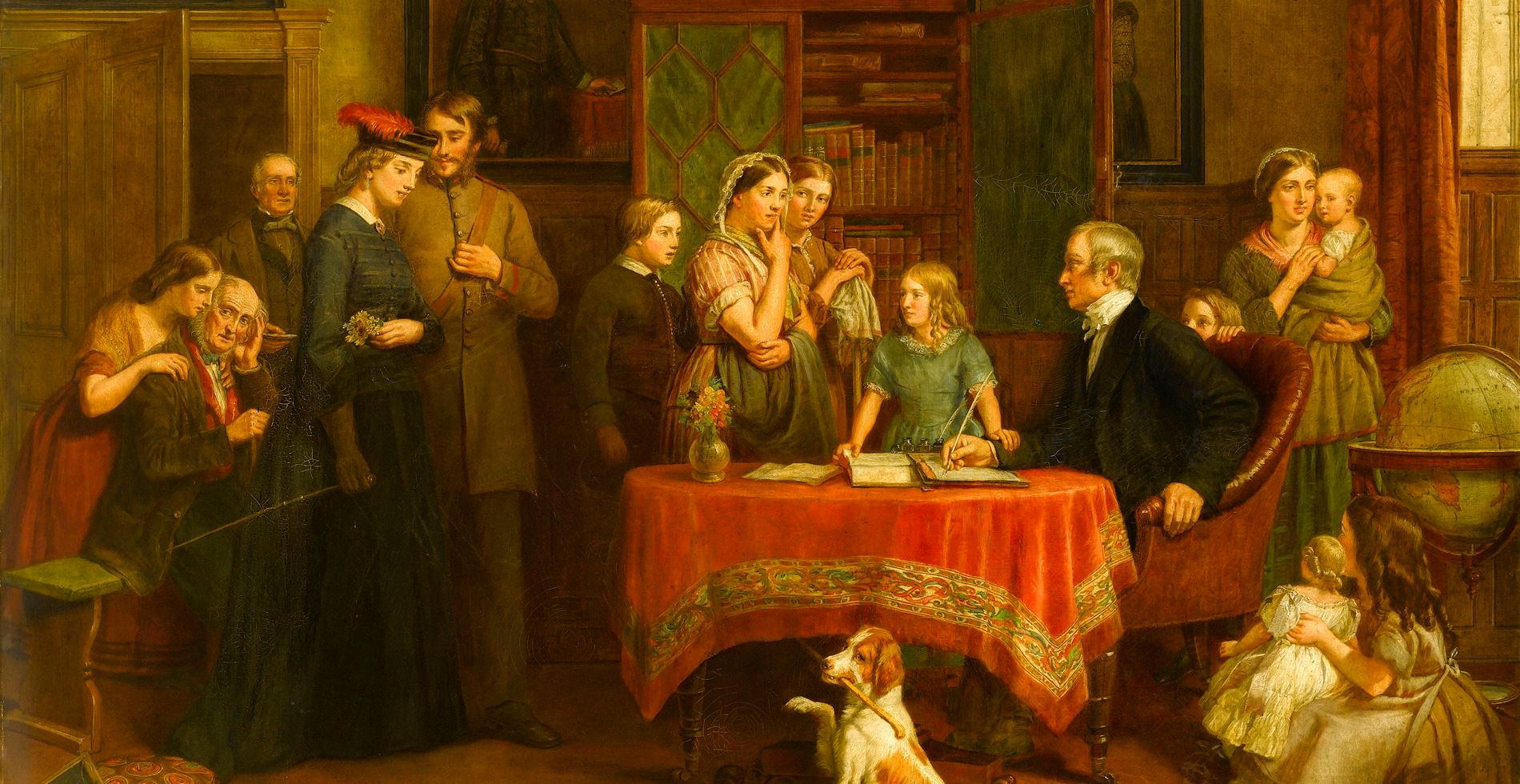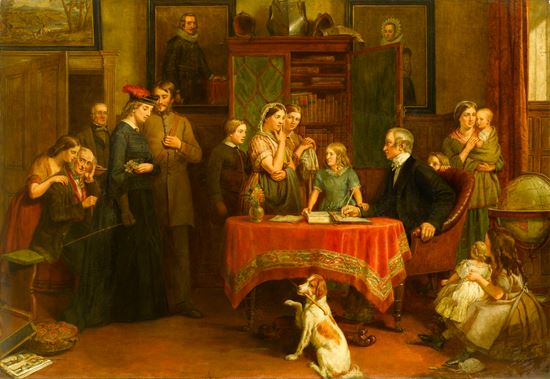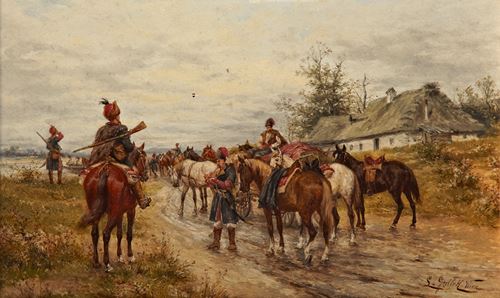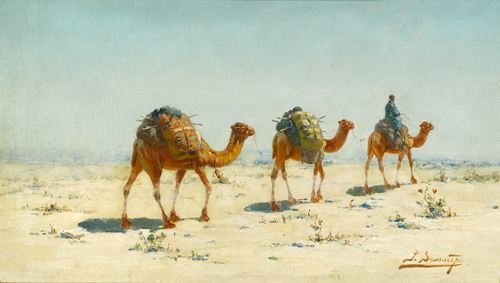harles Landseer
(London 1799 - London 1879)
The Census of April the 8<sup>th</sup>, 1861
inscribed on an old label attached to the stretcher;
19/Royal Academy 1861/The Census April 8th 1861/The Cook - ‘I never did tell nobody, and shan’t tell nobody.’
oil on canvas
99 x 142 cm (39 x 56 in)
This finely detailed work gives an insight into Victorian life and society. In 1861 Charles Landseer exhibited another painting at the Royal Academy with a similar subject to this picture, entitled Births, Deaths and Marriages. The present picture, The Census of April the 8th, 1861, exhibited the following year depicts the well appointed home of a local registrar, who is compiling the census report of 1861. Around him various people are gathered, waiting their turn to give their details, meanwhile the registrar tries to persuade a young cook to answer his questions, her sleeves rolled up from domestic work. As a contemporary critic said, the cook ‘looks as if she'd rather be passed under the mangle than tell her own age.’¹ Behind the cook, awaits a widow dressed in mourning colours, supported perhaps by her brother. She appears upset that she will have to give her status as a widow and appears frail as she enters the room. The children and a playful dog are unconcerned by the importance of the event and merely await the time when playtime can resume. The scene of an obdurate cook, reluctant to divulge her age, is an amusing one, comparable to a famous Punch cartoon, in which an elderly servant confidently ‘admits’ that she is “Twenty last Birthday!”
Landseer was a Victorian artist who was primarily concerned with realism and narrative works. He was also a member of a group of artists called the St. John’s Wood Clique that included George Adolphus Storey (1834-1919), David Wilkie Wynfield (1837-1887) and William Frederick Yeames (1835-1918), and which painted historical and narrative scenes. Although their work was popular with the public, they were never critically acclaimed. Charles never achieved the same level of fame as his better known, and more successful, younger brother Edwin Landseer (1802-1873). While Edwin’s works were praised for their expression and drama, Charles was known instead for his composition and technical excellence.
Like his sibling, Charles studied under their father, the engraver John Landseer (1763-1852), and subsequently with the great history painter Benjamin Robert Haydon (1786-1846). In 1816 he entered the Royal Academy Schools where he was taught by John Henry Fuseli (1741-1825). Both Haydon and Fuseli saw painting as a very high-minded activity, and the sincerity and meticulous attention to detail in this work reflect their ideals. Characteristically, in The Census of April the 8th, 1861, Landseer has created a finely observed and detailed narrative scene, typical of the Victorian period.
In 1823 Landseer accompanied Sir Charles Stuart de Rothesay (1779-1845) aboard HMS Wellesley on a voyage to Portugal and then to Brazil, in order to negotiate a commercial treaty with Pedro I, Emperor of Brazil. Many of the drawings he made on this trip were exhibited in 1828 at the British Institution. In that year he sent his first painting to the Royal Academy; this was Dorothea, illustrating a scene from Cervantes’ Don Quixote (1605). He continued to exhibit at the Academy until his death, showing mostly romanticised history paintings: for example, the Plundering of Basing House; or such literary subjects such as Clarissa Harlowe in the Sponging House from Samuel Richardson’s novel Clarissa (1748), both paintings were exhibited at the Royal Academy, in 1836 and 1833 respectively, and are held at the Tate Gallery, London. The English Civil War (1642-51) was of particular interest to him, this can be seen in The Census of April the 8th, 1861 by Landseer’s inclusion of the seventeenth-century portraits and armour hung on the wall. His devotion to such historical subjects perhaps being attributable to the influence of his years with Haydon. He also painted portraits, genre scenes and animal studies.
In 1837 he was elected ARA and in 1845 RA. Six years later, probably due to the influence of his brother Edwin, he succeeded George Jones (1786-1869) as Keeper of the Royal Academy Schools, where he was responsible for instructing the antique class, remaining in the position until his retirement from the Keepership in 1873. He bequeathed 10,000 guineas to the Royal Academy for the foundation of the Landseer Scholarships.
¹ The London Review of Politics... see Literature.
The Art Journal, June 1863.
The London Review of Politics, Society, Literature, Art, and Science, vol.vi, January-June 1863, p.486.
Samuel Orchart Beeton, Beeton's Men of the Age and Annals of the Time (Ward, Lock & Tyler, London, 1874), p. 130.
London, Royal Academy, 1862, no. 79.
This finely detailed work gives an insight into Victorian life and society. In 1861 Charles Landseer exhibited another painting at the Royal Academy with a similar subject to this picture, entitled Births, Deaths and Marriages. The present picture, The Census of April the 8th, 1861, exhibited the following year depicts the well appointed home of a local registrar, who is compiling the census report of 1861. Around him various people are gathered, waiting their turn to give their details, meanwhile the registrar tries to persuade a young cook to answer his questions, her sleeves rolled up from domestic work. As a contemporary critic said, the cook ‘looks as if she'd rather be passed under the mangle than tell her own age.’¹ Behind the cook, awaits a widow dressed in mourning colours, supported perhaps by her brother. She appears upset that she will have to give her status as a widow and appears frail as she enters the room. The children and a playful dog are unconcerned by the importance of the event and merely await the time when playtime can resume. The scene of an obdurate cook, reluctant to divulge her age, is an amusing one, comparable to a famous Punch cartoon, in which an elderly servant confidently ‘admits’ that she is “Twenty last Birthday!”
Landseer was a Victorian artist who was primarily concerned with realism and narrative works. He was also a member of a group of artists called the St. John’s Wood Clique that included George Adolphus Storey (1834-1919), David Wilkie Wynfield (1837-1887) and William Frederick Yeames (1835-1918), and which painted historical and narrative scenes. Although their work was popular with the public, they were never critically acclaimed. Charles never achieved the same level of fame as his better known, and more successful, younger brother Edwin Landseer (1802-1873). While Edwin’s works were praised for their expression and drama, Charles was known instead for his composition and technical excellence.
Like his sibling, Charles studied under their father, the engraver John Landseer (1763-1852), and subsequently with the great history painter Benjamin Robert Haydon (1786-1846). In 1816 he entered the Royal Academy Schools where he was taught by John Henry Fuseli (1741-1825). Both Haydon and Fuseli saw painting as a very high-minded activity, and the sincerity and meticulous attention to detail in this work reflect their ideals. Characteristically, in The Census of April the 8th, 1861, Landseer has created a finely observed and detailed narrative scene, typical of the Victorian period.
In 1823 Landseer accompanied Sir Charles Stuart de Rothesay (1779-1845) aboard HMS Wellesley on a voyage to Portugal and then to Brazil, in order to negotiate a commercial treaty with Pedro I, Emperor of Brazil. Many of the drawings he made on this trip were exhibited in 1828 at the British Institution. In that year he sent his first painting to the Royal Academy; this was Dorothea, illustrating a scene from Cervantes’ Don Quixote (1605). He continued to exhibit at the Academy until his death, showing mostly romanticised history paintings: for example, the Plundering of Basing House; or such literary subjects such as Clarissa Harlowe in the Sponging House from Samuel Richardson’s novel Clarissa (1748), both paintings were exhibited at the Royal Academy, in 1836 and 1833 respectively, and are held at the Tate Gallery, London. The English Civil War (1642-51) was of particular interest to him, this can be seen in The Census of April the 8th, 1861 by Landseer’s inclusion of the seventeenth-century portraits and armour hung on the wall. His devotion to such historical subjects perhaps being attributable to the influence of his years with Haydon. He also painted portraits, genre scenes and animal studies.
In 1837 he was elected ARA and in 1845 RA. Six years later, probably due to the influence of his brother Edwin, he succeeded George Jones (1786-1869) as Keeper of the Royal Academy Schools, where he was responsible for instructing the antique class, remaining in the position until his retirement from the Keepership in 1873. He bequeathed 10,000 guineas to the Royal Academy for the foundation of the Landseer Scholarships.
¹ The London Review of Politics... see Literature.
The Art Journal, June 1863.
The London Review of Politics, Society, Literature, Art, and Science, vol.vi, January-June 1863, p.486.
Samuel Orchart Beeton, Beeton's Men of the Age and Annals of the Time (Ward, Lock & Tyler, London, 1874), p. 130.
London, Royal Academy, 1862, no. 79.





 contact
contact +44 20 7313 8040
+44 20 7313 8040









